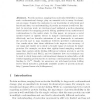Free Online Productivity Tools
i2Speak
i2Symbol
i2OCR
iTex2Img
iWeb2Print
iWeb2Shot
i2Type
iPdf2Split
iPdf2Merge
i2Bopomofo
i2Arabic
i2Style
i2Image
i2PDF
iLatex2Rtf
Sci2ools
RECOMB
2006
Springer
2006
Springer
Simulating Protein Motions with Rigidity Analysis
Abstract. Protein motions, ranging from molecular flexibility to largescale conformational change, play an essential role in many biochemical processes. Despite the explosion in our knowledge of structural and functional data, our understanding of protein movement is still very limited. In previous work, we developed and validated a motion planning based method for mapping protein folding pathways from unstructured conformations to the native state. In this paper, we propose a novel method based on rigidity theory to sample conformation space more effectively, and we describe extensions of our framework to automate the process and to map transitions between specified conformations. Our results show that these additions both improve the accuracy of our maps and enable us to study a broader range of motions for larger proteins. For example, we show that rigidity-based sampling results in maps that capture subtle folding differences between protein G and its mutations, NuG1 and NuG2, and ...
Computational Biology | Conformational Changes | Large-scale Conformational Changes | RECOMB 2006 | Subtle Folding Differences |
| Added | 03 Dec 2009 |
| Updated | 03 Dec 2009 |
| Type | Conference |
| Year | 2006 |
| Where | RECOMB |
| Authors | Shawna L. Thomas, Xinyu Tang, Lydia Tapia, Nancy M. Amato |
Comments (0)

